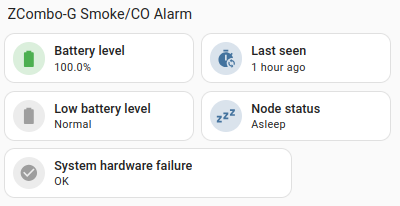@freshcoast, Thank you! I have a followup and a couple additional questions and some tips for other users:
-
So these buttons are to manually clear or reset (or what they call “idle”) an alarm signal we received. But they are only needed if we might have missed seeing the followup that the First Alert sent which says Alarm silenced like when the smoke has finally cleared. This situation would leave the Home Assistant still thinking the smoke is present and has not gone away even though it actually has? So the Idle Smoke|CO Alarm status buttons are to fix that unlikely quagmire manually. Have I got that right?
-
Also we have Alarm status and Sensor status buttons.
What’s the difference between an Alarm and a Sensor? I’m guessing that an Alarm is an event that occurs when smoke or CO2 is first detected above safe levels. But then what is a Sensor? Is that perhaps true while smoke or CO2 continues to exists?
-
And then we have CO Alarm Maintenance status and System Hardware status. What are they? And out of curiosity do they have anything to do with the Replacement required, End-of-life entity?
And out of curiosity, should we expect that this device will just die in 7 years (it’s rated lifespan) due to engineered planned obsolescence? Hum?
Is possibly Maintenance the requested monthly manual unit tests, i.e. by pressing the button.
(LOL, no one gets out a ladder and does that monthly test only to have to hurt their ears, but I get this company is trying to protect themselves from law suits, so they say to do this.)
(I sure would like to find a more robust device than this one.)
Additional Documentation found
I found what looks like another PDF for this device here: https://www.manualslib.com/download/2863944/First-Alert-Zcombo.html (It’s the same text as the micro-print rag sheet they sent with the product, that is hard for us old guys to read without a magnifying glass, but rather in a normal sized PDF page format.)
First Alert Z-Wave specifications missing
BTW, First Alert, IMHO. is not being helpful at their web site. They say in their instructions and in their web site the following: “For more information on Z-Wave specifications, visit www.firstalert.com/zwaveinfo.” But this page they refer us to at https://www.firstalert.com/zwaveinfo/ seems broken. I tried it in both Firefox and Chrome. It doesn’t seem to lead to any sort of specifications. Does anyone have a copy of these Z-Wave specifications that they refer to?
Garage use
I’m putting this in my garage to get an early warning of trouble. But note that First Alert doesn’t want it in a garage, and they don’t want it cold. So I want to fully understand how this device is suppose to work, so that if it seems to not be working I can quickly address it.
Interconnecting smoke alarms
First alert says that this device can not be interconnected.
See https://support.firstalert.com/s/article/Ways-to-Interconnect-Alarms "
Do Z-Wave alarms interconnect?
No. …
What that means is that when one device detects smoke that all devices installed in the premise scream. Normally they are physically wired together in a daisy chain. But as I recall I think the current fire code requires this interconnected functionality. So therefore, this First Alert device is not rated to be used except alone as the only single unit in a doweling, which seems very limiting.
Still, I don’t care about that for my use of it. Smoke alarms are not to detect smoke, they are to save lives.
But in my use this is to detect smoke like from a faulty lithium tool battery so that I can try to save my garage from burning down if something smokes when I’m not there. We’ll see how the welder sets it off. 
First Alert’s ‘Contact us’ link is broken
If you go to Customer Service at the First Alert site and then Contact us you get:
URL No Longer Exists
You have attempted to reach a URL that no longer exists on salesforce.com.
You may have reached this page after clicking on a direct link into the application. This direct link might be:
• A bookmark to a particular page, such as a report or view
• A link to a particular page in the Custom Links section of your Home Tab, or a Custom Link
• A link to a particular page in your email templates
If you reached this page through a bookmark, you are probably trying to access something that has moved. Please update your bookmark.
If you reached this page through any of the other direct links listed above, please notify your administrator to update the link.
If you reached this page through a link on our site, please report the broken link directly to our Support Team and we will fix it promptly. Please indicate the page you were on when you clicked the link as well as any other related information. We apologize for the inconvenience.
Thank you again for your patience and assistance. And thanks for using salesforce.com!




